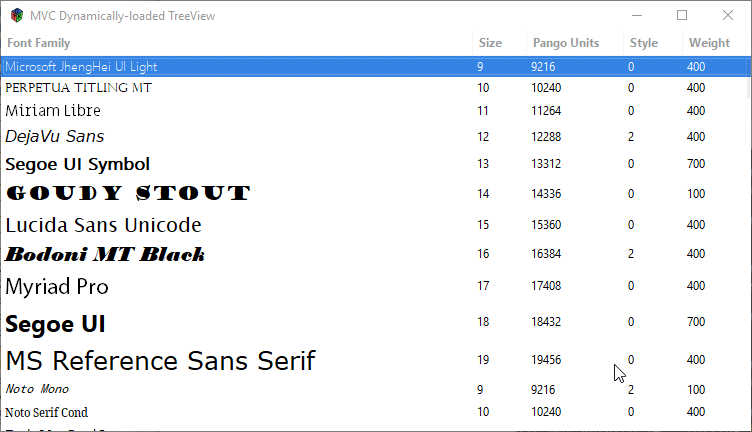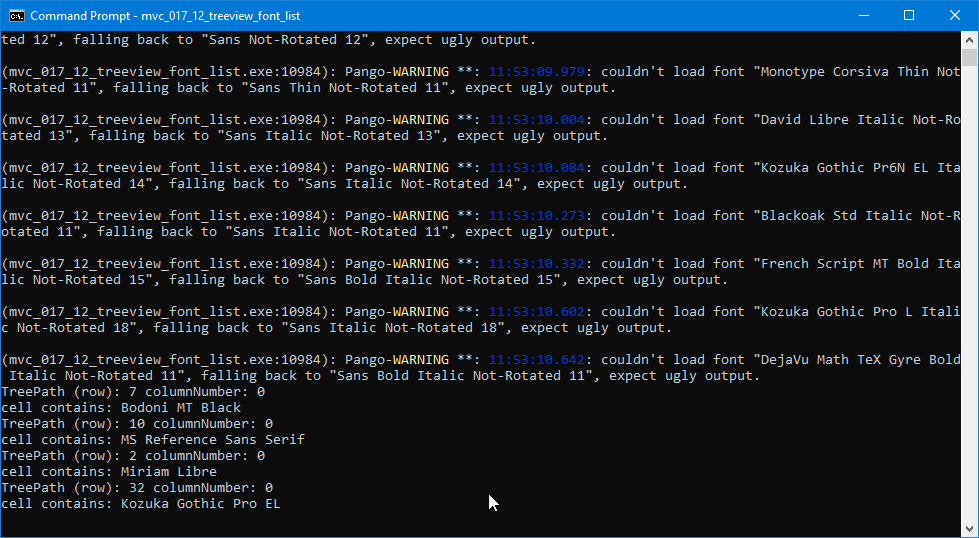0055: MVC VIII – Dynamically Loading a TreeView


This time we’re going to dynamically load the TreeView with a list of all fonts available on your computer. We’ll use PgFontDescriptions (Pango fonts) so we can play with not just the names, but the sizes, styles, and weights. And on top of that, we’ll use a bit of math to mix things up and give the list some variety.
A Note for Windows Users
In the Command Prompt window, you may or may not see Pango warnings for a bunch of fonts. They still load and the fonts are certainly usable, so it’s no big deal.
And now, let’s dig in and start by talking about…
The Imports
To get all this working takes a whole mess of imports:
import std.stdio;
import std.math;
import gtk.MainWindow;
import gtk.Main;
import gtk.Widget;
import gtk.Box;
import gtk.ScrolledWindow;
import gtk.TreeView;
import gtk.ListStore;
import gtk.TreeIter;
import gtk.TreePath;
import gtk.TreeViewColumn;
import gtk.CellRendererText;
import pango.PgCairoFontMap;
import pango.PgFontMap;
import pango.PgFontFamily;
import pango.PgFontDescription;
Now, since the TreeView and TreeViewColumns are pretty much the same as what we’ve done (by now) so many times before, I’ll just comment on things that are different.
FontTreeView Class
The constructor is very much the same as what we’ve seen before and only departs from that norm with this:
fontFamilyColumn = new FontFamilyColumn(fontListStore);
appendColumn(fontFamilyColumn);
The zeroth column constructor (FontFamilyColumn) needs access to the fontListStore so it can pass along data from the PgFontDescriptions in the Model to its CellRenderer as it displays the names of the fonts.
The Callback
The other thing that’s done here in the constructor is, we hook up a callback to react whenever the user double-clicks on a cell in the TreeView. The signal is onRowActivated and the hook-up is the simple one we’ve used so often:
addOnRowActivated(&onRowActivated);
The purpose of the callback is to report which cell has been clicked and it looks like this:
void onRowActivated(TreePath treePath, TreeViewColumn tvc, TreeView tv)
{
int columnNumber;
TreeIter treeIter = new TreeIter(fontListStore, treePath);
// find the column number...
if(tvc.getTitle() == "Font Family")
{
columnNumber = 0;
}
else if(tvc.getTitle() == "Size")
{
columnNumber = 1;
}
else if(tvc.getTitle() == "Pango Units")
{
columnNumber = 2;
}
else if(tvc.getTitle() == "Style")
{
columnNumber = 3;
}
else if(tvc.getTitle() == "Weight")
{
columnNumber = 4;
}
writeln("TreePath (row): ", treePath, " columnNumber: ", columnNumber);
writeln(); // a blank line to separate each report
auto value = fontListStore.getValue(treeIter, columnNumber);
writeln("cell contains: ", value.getString());
And here’s what it does:
- use the
TreePathto get the row number, - also using the
TreePath, we create aTreeIteras a handle for the row data (in other words, theTreePathgives us the visible row in theTreeView, theTreeItergives us the corresponding row in theListStore), - look up the column number using the column’s header text,
- (purely for informational purposes) echo the row and column numbers to the terminal, and
- use the
TreeIter(which, remember, is a handle for the row where the data is stored), and - the
columnNumberto grab the value of the specific cell that was clicked.
The FontListStore Class
This class is a bit different from others we’ve used, starting with the initialization section:
class FontListStore : ListStore
{
SysFontListPango sysFontListPango;
PgFontDescription[] fontList;
TreeIter treeIter;
enum Column
{
FAMILY = 0,
SIZE,
PANGO_SIZE,
STYLE,
WEIGHT,
FONT_DESC
} // enum Column
We’re only working with one array, the fontList which is an array of Pango font descriptions.
In the Column enum, we take advantage of D’s enum auto-numbering which amounts to: number the first item and D fills in the numbers for the rest automatically.
The FontListStore Constructor
this()
{
super([GType.STRING, GType.STRING, GType.STRING, GType.STRING, GType.STRING, PgFontDescription.getType()]);
sysFontListPango = new SysFontListPango();
fontList = sysFontListPango.getList();
foreach(font; fontList)
{
treeIter = createIter();
setValue(treeIter, 0, font.getFamily());
setValue(treeIter, 1, font.getSize() / 1024);
setValue(treeIter, 2, font.getSize());
setValue(treeIter, 3, font.getStyle());
setValue(treeIter, 4, font.getWeight());
setValue(treeIter, 5, font);
}
} // this()
I’ll throw in a quick reminder here that text and numbers are both rendered as strings—which explains the first five GTypes in the array passed to the super-class constructor. But you’ll notice the last item in the array self-identifies using PgFontDescription.getType().
Then we:
- instantiate a
SysFontListPangoobject that we’ll look at in a moment, - get the list of
PgFontDescriptionsfrom it, and - use the data from each
PgFontDescriptionin theforeach()loop to set up the data for the columns.
The SysFontListPango Class
Here’s the constructor (note: all variables starting with an underscore (_) are private to this class and so is counter):
this()
{
_pgFontMap = PgCairoFontMap.getDefault();
_pgFontMap.listFamilies(_pgFontFamilies);
counter = 1;
foreach(_font; _pgFontFamilies)
{
_fontDesc = new PgFontDescription(_font.getName(), _fontSize);
_pgFontDescriptions ~= _fontDesc;
if(fmod(counter, 4) == 0)
{
varyFontBySize();
}
if(fmod(counter, 5) == 0)
{
varyFontByWeight(PangoWeight.BOLD);
}
else if(fmod(counter, 6) == 0)
{
varyFontByWeight(PangoWeight.THIN);
}
_fontSize++;
counter++;
if(_fontSize > 19)
{
_fontSize = 9;
}
}
} // this()
We grab a list of fonts from the system and use it to create a Pango FontMap (referred to as a PgFontMap). From the PgFontMap (essentially just a list of font names) the constructor uses a foreach() loop to create the array of PgFontDescriptions.
And right in the middle of this, we see why std.math was imported…
The fmod() function is used three times so we can make:
- every 4th font italics,
- every 5th font heavy (bold), and
- every 6th font light (thin).
I’ll leave you to explore the other class functions—varyFontBySize(), varyFontByWeight(), and getList()—which are all straightforward.
Reiteration of the Font-grabbing Process
Even though this example is about populating a TreeView on the fly and the font stuff is secondary, I’d feel remiss if I didn’t go over this process in a more linear fashion to make it as clear as possible. Here’s what happens:
- in the
SysFontListPangoclass, we:- get the default font map from the system using
PgCairoFontMap.getDefault()and - stuff it into a
PgFontMap, - then we call
PgFontMap.listFamilies()to stuff this list into aPgFontFamilyarray. - Then—in a
foreach()loop—we usePgFontFamily.getName()to instantiate an array ofPgFontDescriptions.
- get the default font map from the system using
- That array of
PgFontDescriptionsis then accessed by theFontListStoreclass to build its model. - Finally, the
FontTreeViewclass uses theFontListStoremodel to decorate itself.
Conclusion
A bit long this time, but it was either go long or break this out into two posts which I really didn’t want to do.
And what we’ve covered—fiddling with fonts in a ListStore—is really just a precursor for what we’ve got coming next time. We’ll go back to the ComboBox and do some serious window dressing on it, using images and PgFontDescriptions to make something really fancy.
Until then, happy computing.
Comments? Questions? Observations?
Did we miss a tidbit of information that would make this post even more informative? Let's talk about it in the comments.
- come on over to the D Language Forum and look for one of the gtkDcoding announcement posts,
- drop by the GtkD Forum,
- follow the link below to email me, or
- go to the gtkDcoding Facebook page.
You can also subscribe via RSS so you won't miss anything. Thank you very much for dropping by.
© Copyright 2025 Ron Tarrant
